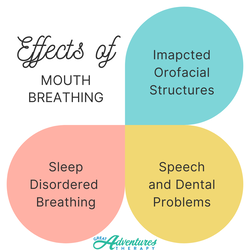|
We’ve all seen it before– the kids watching TV, doing homework, or participating in an activity– sitting with their mouths wide open. Most of the time, they are completely unaware that their mouths aren’t closed! Chances are, they are breathing through their mouth. Did you know that this is actually NOT normal? During normal breathing, the tongue rests on the roof of the mouth, lips are closed, and inhalations and exhalations are all made through the nose. This is done quietly with little to no effort involved. When someone breathes through their mouth, however, the tongue is sitting low and forward in the mouth, breathing is more audible, and the pace of breath is typically faster than normal. For those that habitually mouth-breathe, this can have a long-lasting effect on a child’s health, including the development of facial structures. What are some of the negative effects of mouth breathing/open mouth posture? Impacted orofacial structures. When the tongue rests at the bottom of the mouth, it promotes vertical growth. This can cause what is known as “long-face syndrome,” where the face grows more vertical over time. This also leads to underdevelopment of the upper jaw, which can lead to physical issues such as a narrow mouth, crowded teeth, and poor posture.
Sleep disordered breathing. Mouth breathing can send the body into a constant state of stress and this makes breathing more difficult. Children need to enter deep sleep cycles, as this is imperative for brain development. When they breathe through their mouth, it causes an imbalance of carbon dioxide in the bloodstream, and less oxygen reaches the brain. This can cause fatigue, chronic tiredness, and/or brain fog. Continued mouth breathing can lead to snoring and sleep apnea. Speech and dental problems. A child with abnormal muscle patterns may develop a lisp or have difficulty articulating sounds, which can lead to speech sound disorders. In regards to dentition, when we breathe through our mouth, there is no way to filter air coming in, unlike breathing through the nose, causing more foreign particles to enter the body. This can cause dry mouth, bad breath, and cavities. My child breathes through their mouth. What do I do? Evaluate the airway. If we can’t breathe, we can’t live! We always want to ensure that a child’s airway is adequate for breathing. Check the tonsils- are they enlarged? Can you see the child’s airway when they say, “ahhh?” If you have concerns about the adequacy of the child’s airway, ask your pediatrician or visit your local ENT. They can make sure that everything anatomically looks normal. Address any nasal congestion. If you cannot breathe clearly through your nose, then you have no choice but to breathe through your mouth! This may be as simple as allergy medicine if your child suffers from seasonal allergies, and taking step to reduce allergens in and around your home. Visit a Myofunctional Therapist. There are three “rules” in Myofunctional Therapy: 1) Lips closed 2) Tongue up 3) Breathe through the nose. Think of this type of therapy as physical therapy for mouth, tongue, and face. Retraining the muscles how to work and rest properly can greatly assist your child in improving their breathing, their facial development, and overall quality of life. If you are in the Knoxville area and think your child may benefit from myofunctional therapy, please give us a call at (865) 236-0103 for a free consultation. We’d love to meet you!
0 Comments
|
AuthorChariti is a licensed/certified Speech Language Pathologist in Knoxville, Tennessee and owner of Great Adventures Therapy. LLC. Archives
December 2022
Categories |
9000 Executive Park Drive Suite #A205
Knoxville, TN 37923
Phone: (865) 236-0103
Fax: (865) 674-5447
[email protected]
Knoxville, TN 37923
Phone: (865) 236-0103
Fax: (865) 674-5447
[email protected]


 RSS Feed
RSS Feed
